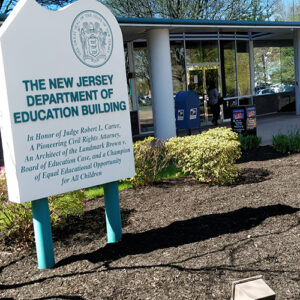
Can Mikie Sherrill Get the Democratic Party Out of Its Rut?
July 28, 2025
Are NJ Parents Of Students With Disabilities Finally Getting Some Power?
August 11, 2025New Jersey Gets a “D” For Fair School Funding. Does It Matter?
New Jersey’s Education Law Center, which made its bones litigating the famous Abbott v. Burke cases and changing the way New Jersey funds schools, has a new report out. “Making the Grade” is ambitious, rating every state on whether its school funding formula comports with Education Law Center’s (ELC) Fair Funding Formula and concluding that, while progress has been made in shifting more aid to needier students and away from wealthier ones, America still has a long way to go.
Two observations before we dive into NJ’s grades:
- ELC fails to consider an important factor: whether the money directed through state funding formulas results in improved student outcomes. As such, the report is all inputs and no outputs. Is extra money helping students learn? To ELC, such calculations are irrelevant because higher funding must lead to higher achievement. (Hint: it doesn’t.)
- There is a not-so-hidden agenda driving the report: a screed against universal voucher programs currently enacted in 12 states, which ELC sees as an “unmitigated disaster” that de-funds traditional public schools. (ELC is not referring to the new federal law but to individual state programs.)
ELC’s formula for Fair Funding has three parts: Funding Level (per pupil revenue from state and local sources), Funding Distribution (whether the state gives additional funds to high-poverty districts), and Funding Effort (pre-k-12 public education funding as a percentage of the state’s GDP).
New Jersey gets an “A” grade on Funding Level because it allots an annual per pupil cost of $23,496, bested only by New York and Vermont. But it gets a “D” for Funding Distribution because low-poverty districts get $150 more per pupil than high-poverty districts (which are averages, not accounting for some high-poverty districts like Asbury Park, Camden, and Newark that get a lot more). We also get a “D” on Funding Effort, which looks at whether states have become more or less progressive over the decade 2012-2022. (The report notes the vast amount of federal infusion from Covid funds, although that didn’t really start affecting bottom lines until 2022-2023.)
In other words, New Jersey is backsliding from the Abbott era that gave us the distinction of having one of the most progressive school funding formulas in the country.
This is useful information. However, it neglects to factor in whether states that allot more money are using that money effectively; after all, money is necessary for promoting student achievement but is insufficient without high quality curricula, great teachers, and accountability.
Example: ELC gives Mississippi an “F” in Funding Level because it only allots $12,252 per student, the fourth lowest in the country, and a “C” in Funding Distribution because high-poverty districts only get $500 more than low-poverty districts. But the report doesn’t bother to note that reading scores there have risen dramatically because of adherence to science of reading programs and robust teacher development.
Chad Aldeman, in his write-up in The 74, creates a chart that looks at states’ reading levels (demographically-adjusted) and how much they spend per pupil. Here NJ is the third-highest in spending but far below Mississippi, Texas, and Florida in student proficiency levels, all states that spend far less:

As Aldeman says, “the relationship between school spending and student outcomes is weaker than you might imagine.”
(Also see this report from Georgetown’s Edunomics Lab on states’ ROI, or Return on Investment, in K-12 education: Here is NJER’s write-up.)
The report then pivots to an attack on state voucher programs. For example, Arizona’s “unfettered growth of the program, paired with a dire lack of accountability, has been an unmitigated disaster.” Certainly, one can posit that vouchers without guardrails can be harmful but that’s not ELC’s beef. Never has been. Over the last 20 years the non-profit has regarded school choice, both public and private, as a turf war, a battle of market share. (Unsurprisingly, ELC is largely funded by NJ’s teacher union; some jest that it functions as NJEA’s legal arm. It opposes public charter schools on general principle, despite their popularity in NJ among low-income parents of color, and swiftly condemns Education Savings Accounts, even those limited to high-poverty families.)
These issues are complex. Schools need enough money, teachers need adequate support, and students need to learn how to read and do math. Sufficient funding is essential but not the only factor in measuring the strength of state school systems.
Hot Takes on NAEP —and What New Jersey Needs To Do




